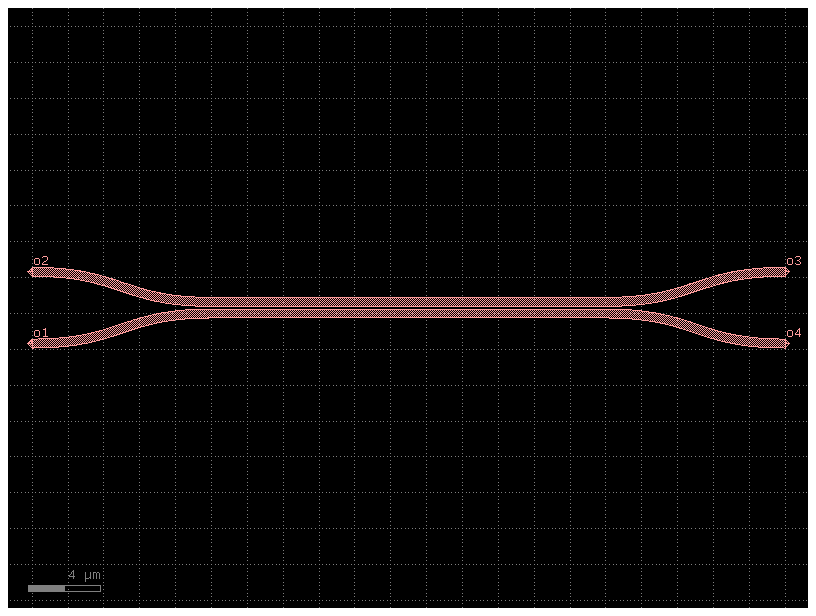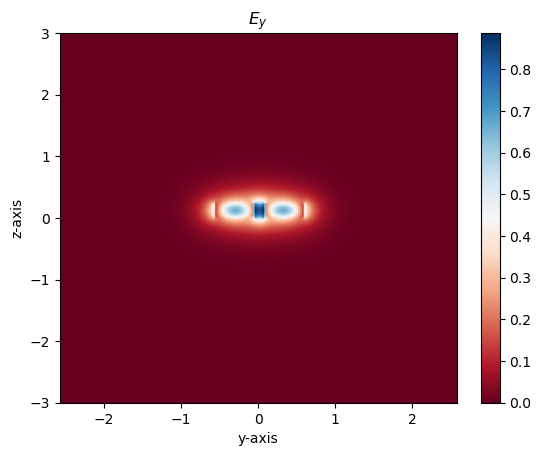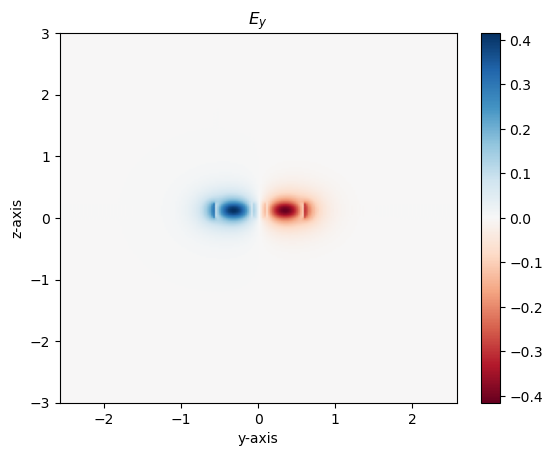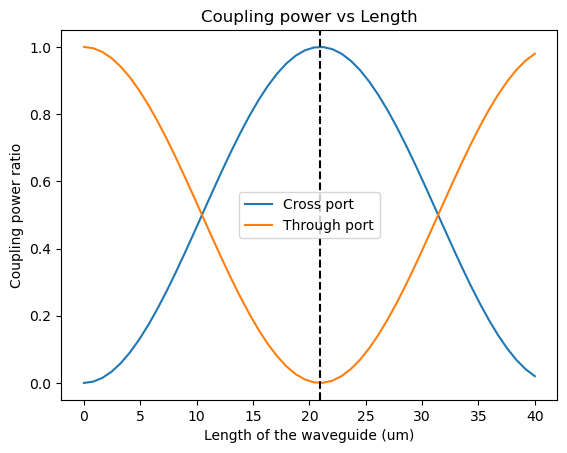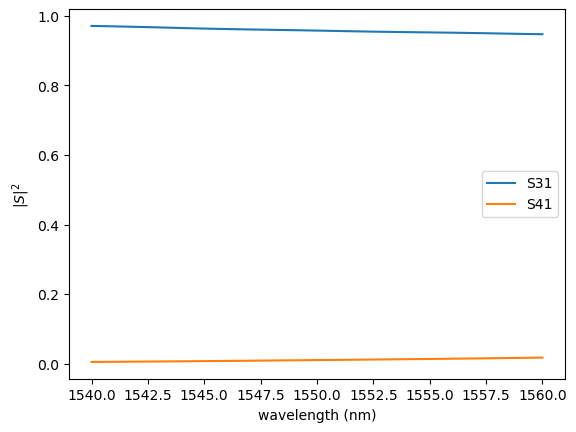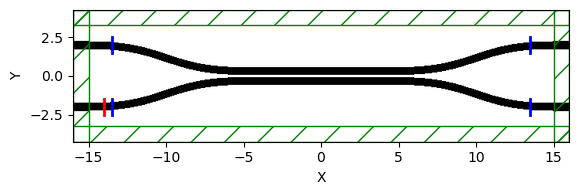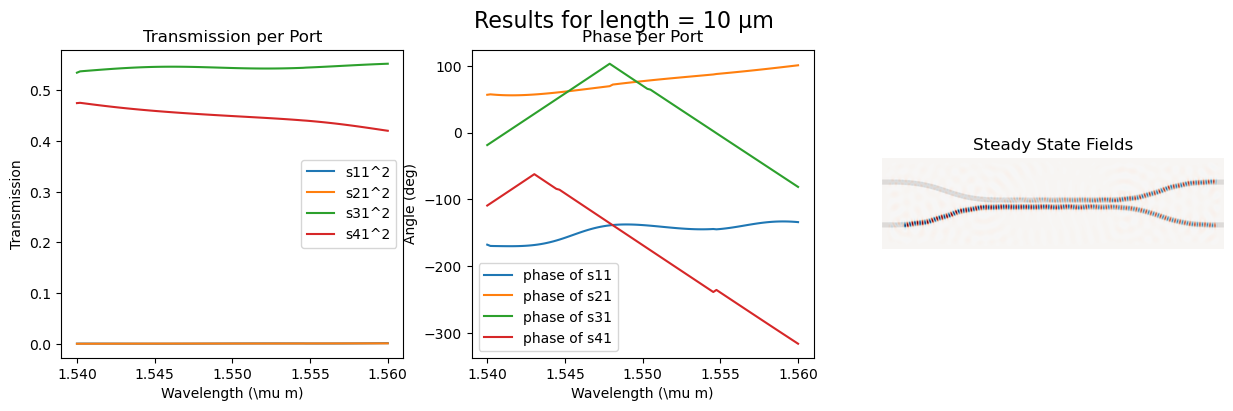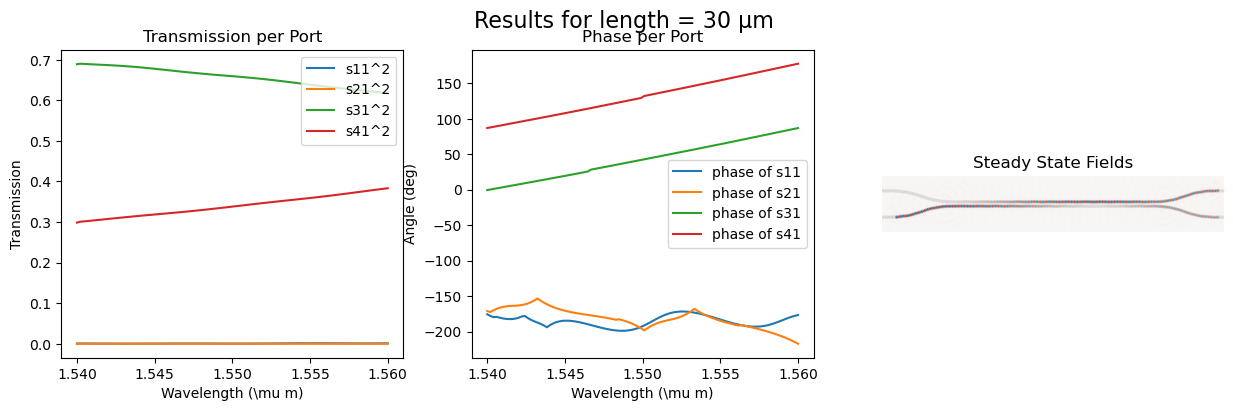Directional Coupler
Directional Coupler
Source Code
1
2
3
4
5
6
7
# Import all the necessary packages
import gplugins.modes as gmode
import numpy as np
import matplotlib.pyplot as plt
import meep as mp
import gdsfactory as gf
import gplugins.gmeep as gm
1
2
Using MPI version 4.1, 1 processes
[32m2025-10-02 00:21:52.537[0m | [1mINFO [0m | [36mgplugins.gmeep[0m:[36m<module>[0m:[36m39[0m - [1mMeep '1.31.0' installed at ['/home/ramprakash/anaconda3/envs/si_photo/lib/python3.13/site-packages/meep'][0m
Visualzing supermodes
Using gdsfactory and gplugins we can visualize the supermodes and effective index of even and odd modes
Source Code
1
2
3
4
5
6
7
8
9
10
11
12
13
14
15
16
17
18
19
20
21
22
23
24
modes = gmode.find_modes_coupler(
core_widths=(0.5, 0.5),
gaps=(0.15,), # CHANGE GAP VALUE
core_material=3.45,
clad_material=1.45,
core_thickness=0.22,
resolution=40,
sz=6,
nmodes=2,
)
m1 = modes[1] # even mode
m2 = modes[2] # odd mode
# Look to see how big of a difference there is between the two refractive indices
print("Refractive index of even mode:", m1.neff)
print("Refractive index of odd mode:", m2.neff)
# Plot the dielectric, shows index of refraction values in sidebar
m1.plot_eps()
# Plot the Electric field intensity of the modes
m1.plot_ey()
m2.plot_ey()
1
2
Refractive index of even mode: 2.412356873283017
Refractive index of odd mode: 2.3769074396552754
Coupling length vs gap between the waveguides
Using gdsfactory helper function ‘find_coupling_vs_gap’
Source Code
1
2
3
4
5
6
7
8
9
10
11
12
13
14
15
16
17
import meep as mp
coupling_gap = gmode.find_coupling_vs_gap(
gap1=0.1,
gap2=0.15,
steps=11,
nmodes=1,
wavelength=1.55,
parity=mp.EVEN_Y,
core_widths=(0.5, 0.5),
core_material=3.45,
clad_material=1.45,
core_thickness=0.22,
resolution=40,
sz=6,
)
coupling_gap
1
0%| | 0/11 [00:00<?, ?it/s]
| gap | ne | no | lc | dn | |
|---|---|---|---|---|---|
| 0 | 0.100 | 2.428738 | 2.371472 | 13.533461 | 0.057265 |
| 1 | 0.105 | 2.426836 | 2.371885 | 14.103476 | 0.054951 |
| 2 | 0.110 | 2.425519 | 2.372191 | 14.532637 | 0.053328 |
| 3 | 0.115 | 2.423959 | 2.372615 | 15.094336 | 0.051344 |
| 4 | 0.120 | 2.423082 | 2.373316 | 15.572816 | 0.049766 |
| 5 | 0.125 | 2.420206 | 2.373469 | 16.582260 | 0.046737 |
| 6 | 0.130 | 2.417458 | 2.373492 | 17.627312 | 0.043966 |
| 7 | 0.135 | 2.415176 | 2.373758 | 18.711407 | 0.041419 |
| 8 | 0.140 | 2.413491 | 2.374407 | 19.828922 | 0.039084 |
| 9 | 0.145 | 2.412899 | 2.375705 | 20.836274 | 0.037195 |
| 10 | 0.150 | 2.412357 | 2.376907 | 21.862126 | 0.035449 |
Coupling power ratio vs length of the waveguide
$\kappa^2 = sin^2(C.L)$ cross coupling ratio
$t^2 = cos^2(C.L)$ through coupling ratio
$C = \frac{\pi\Delta n}{\lambda}$ Coupling coefficient
$c_{length} = \frac{\lambda}{2*\Delta n}$ Cross-over length
gap = 150 nm, n1 = 2.412, n2=2.377
Source Code
1
2
3
4
5
6
7
8
9
10
11
12
13
14
15
16
17
18
gap = 0.150 # in um
n1 = 2.412
n2 = 2.375
dn = 2.412 - 2.375
L = np.linspace(0, 40, 50)
C = np.pi * dn / 1.55 # coupling coeff
k_cross = (np.sin(C * L)) ** 2
t_through = (np.cos(C * L)) ** 2
C_len = 1.55 / (2 * dn)
plt.figure()
plt.plot(L, k_cross, label="Cross port")
plt.plot(L, t_through, label="Through port")
plt.axvline(C_len, color="black", linestyle="--")
plt.xlabel("Length of the waveguide (um)")
plt.ylabel("Coupling power ratio")
plt.title("Coupling power vs Length")
plt.legend()
plt.show()
Meep simulation of coupler
No bend simualtion - two straight waveguide seperated by gap=0.15 um, Length=22 um
Source Code
1
2
3
4
5
6
7
8
9
10
11
12
13
14
15
16
17
18
19
20
21
22
23
24
25
26
27
28
29
30
31
32
33
34
35
36
37
38
39
40
41
42
43
44
45
46
47
48
49
50
51
52
53
54
55
56
57
58
59
60
61
62
63
64
65
66
67
68
69
70
71
72
73
74
75
76
77
78
79
80
81
82
83
84
85
86
87
88
89
90
91
92
93
94
95
96
97
98
99
100
101
102
103
104
105
106
107
108
109
import meep as mp
from PIL import Image
import glob
import os
# Define materials
Si = mp.Medium(index=3.45)
SiO2 = mp.Medium(index=1.45)
# Define wavelength in um
wvl = 1.55
# # Define cell and geometric parameters
resolution = 20
wg_width = 0.5
dpml = 1
pad = 0.5
## CHANGE GAP DISTANCE ##
gap = 0.15
## CHANGE WAVEGUIDE LENGTH ##
Lx = 25
Sx = dpml + Lx + dpml
Sy = dpml + pad + wg_width + gap + wg_width + pad + dpml
wg_center_y = gap / 2 + wg_width / 2
# Add PML (perfectly matched layers)
pml = [mp.PML(dpml)]
# Create 2 infinitely long parallel waveguides
geometry = [
mp.Block(size=mp.Vector3(Sx, Sy, 0), center=mp.Vector3(), material=SiO2),
mp.Block(
size=mp.Vector3(Sx, wg_width, 0),
center=mp.Vector3(0, wg_center_y, 0),
material=Si,
),
mp.Block(
size=mp.Vector3(Sx, wg_width, 0),
center=mp.Vector3(0, -wg_center_y, 0),
material=Si,
),
]
# Put a pulse Eigenmode source at beginning of one waveguide
fcen = 1 / wvl
width = 0.1
fwidth = width * fcen
src = mp.GaussianSource(frequency=fcen, fwidth=fwidth)
source = [
mp.EigenModeSource(
src=src,
eig_band=1,
eig_kpoint=(1, 0, 0),
size=mp.Vector3(0, gap + wg_width),
center=mp.Vector3(-Sx / 2 + dpml + 1, -wg_center_y),
)
]
# Simulation object
sim = mp.Simulation(
cell_size=mp.Vector3(Sx, Sy),
boundary_layers=pml,
geometry=geometry,
sources=source,
default_material=SiO2,
resolution=resolution,
)
# Show simulation set-up
sim.plot2D()
sim.reset_meep()
# Capture electric field intensity over time and output into a gif
sim.run(
mp.at_beginning(mp.output_epsilon),
mp.to_appended("ez_100_DC", mp.at_every(2, mp.output_efield_z)),
until=400,
)
# Since HDf5 was installed locally we need this. For sudo install these steps are not needed
os.environ["PATH"] = os.path.expanduser("~") + "/local/bin:" + os.environ["PATH"]
conda_prefix = os.environ["CONDA_PREFIX"]
os.environ["LD_LIBRARY_PATH"] = (
conda_prefix + "/lib:" + os.environ.get("LD_LIBRARY_PATH", "")
)
os.system(
"h5topng -t 0:99 -R -Zc $HOME/local/share/h5utils/colormaps/RdBu -A eps-000000.00.h5 -a $HOME/local/share/h5utils/colormaps/gray ez_100_DC.h5"
)
# Create a gif from the pngs
frames = []
imgs = glob.glob("ez_100_DC.t*")
imgs.sort()
for i in imgs:
new_frame = Image.open(i)
frames.append(new_frame)
# Save into a GIF file that loops forever
frames[0].save(
"ez_100_DC.gif", format="GIF", append_images=frames[1:], save_all=True, loop=0
)
# Clean up workspace by deleting all generated images
for i in imgs:
os.remove(i)
for f in glob.glob("*.h5"):
os.remove(f)
1
FloatProgress(value=0.0, description='0% done ', max=400.0)
Coupler with bends - S-Parameter
Use write_sparameters_meep from gdsfactory plugins gmeep to get the sparameter of 100% coupler
Use get_geomentry from gdsfacotory to calcaulate S paramters and steady state fields.
Get Field animations
Couplers from gdsfactory component
Source Code
1
2
3
4
5
6
7
8
9
10
11
12
13
14
15
import gdsfactory as gf
gf.clear_cache()
dir_coupler_100 = gf.Component("100% coupler")
gap = 0.15
length_100 = 22
dir_100_ref = dir_coupler_100.add_ref(gf.components.coupler(gap=gap, length=length_100))
dir_coupler_100.add_ports(dir_100_ref.ports)
dir_coupler_100.draw_ports()
dir_coupler_100.plot()
Effective index calcaution for 2.5D simulations (Not accurate like 3D simualtion but close enough and way faster)
Source Code
1
2
3
4
5
6
7
8
9
10
11
12
import gplugins
core_material = gplugins.get_effective_indices(
core_material=3.45,
clad_materialding=1.44,
nsubstrate=1.44,
thickness=0.22,
wavelength=1.55,
polarization="te",
)[0]
core_material
1
2.8217018611269684
Using write_sparameters_meep function
Source Code
1
2
3
4
5
6
7
8
9
10
11
12
13
14
15
16
17
18
19
20
21
22
23
24
25
26
27
28
29
30
31
32
33
34
35
36
37
38
39
40
41
42
43
44
45
46
47
48
49
50
51
52
53
54
55
56
57
58
59
60
61
62
63
64
65
66
67
68
69
import meep as mp
import matplotlib.pyplot as plt
import gplugins.gmeep as gm
mp.verbosity(0)
# Define materials
Si = mp.Medium(index=3.45)
SiO2 = mp.Medium(index=1.45)
resolution = 20
dpml = 1
pad = 1
sx = dpml + -(dir_coupler_100.ports["o1"].x) + (dir_coupler_100.ports["o4"].x) + dpml
sy = (
dpml
+ pad
+ -(dir_coupler_100.ports["o1"].y)
+ (dir_coupler_100.ports["o4"].y)
+ pad
+ dpml
)
port_symmetries_crossing = {
"o1@0,o1@0": ["o2@0,o2@0", "o3@0,o3@0", "o4@0,o4@0"],
"o2@0,o1@0": ["o1@0,o2@0", "o3@0,o4@0", "o4@0,o3@0"],
"o3@0,o1@0": ["o1@0,o3@0", "o2@0,o4@0", "o4@0,o2@0"],
"o4@0,o1@0": ["o1@0,o4@0", "o2@0,o3@0", "o3@0,o2@0"],
}
# plotting the meep geomentry
gm.write_sparameters_meep(
dir_coupler_100,
xmargin_left=1,
xmargin_right=1,
ymargin_top=1,
ymargin_bot=1,
resolution=resolution,
wavelength_start=1.54,
wavelength_stop=1.56,
wavelength_points=100,
tpml=dpml,
port_source_offset=0.2,
port_monitor_offset=-0.1,
port_symmetries=port_symmetries_crossing,
distance_source_to_monitors=0.3,
material_name_to_meep=dict(si=3.45),
run=False,
)
# Running the simulations
sp = gm.write_sparameters_meep(
dir_coupler_100,
xmargin_left=1,
xmargin_right=1,
ymargin_top=1,
ymargin_bot=1,
wavelength_start=1.54,
wavelength_stop=1.56,
wavelength_points=100,
resolution=resolution,
tpml=dpml,
port_source_offset=0.2,
port_monitor_offset=-0.1,
distance_source_to_monitors=0.3,
port_symmetries=port_symmetries_crossing,
material_name_to_meep=dict(si=3.45),
run=True,
)
1
2
3
4
5
6
7
8
9
10
11
12
13
14
/home/ramprakash/anaconda3/envs/si_photo/lib/python3.13/site-packages/meep/visualization.py:966: UserWarning: plot_eps_flag is deprecated. Use show_epsilon instead.
warnings.warn("plot_eps_flag is deprecated. Use show_epsilon instead.")
/home/ramprakash/anaconda3/envs/si_photo/lib/python3.13/site-packages/meep/__init__.py:4446: ComplexWarning: Casting complex values to real discards the imaginary part
return _meep._get_epsilon_grid(gobj_list, mlist, _default_material, _ensure_periodicity, gv, cell_size, cell_center, nx, xtics, ny, ytics, nz, ztics, grid_vals, frequency)
0%| | 0/4 [00:00<?, ?it/s]
/home/ramprakash/anaconda3/envs/si_photo/lib/python3.13/site-packages/meep/__init__.py:4440: ComplexWarning: Casting complex values to real discards the imaginary part
return _meep.create_structure(cell_size, dft_data_list_, pml_1d_vols_, pml_2d_vols_, pml_3d_vols_, absorber_vols_, gv, br, sym, num_chunks, Courant, use_anisotropic_averaging, tol, maxeval, gobj_list, center, _ensure_periodicity, _default_material, alist, extra_materials, split_chunks_evenly, set_materials, existing_s, output_chunk_costs, my_bp)
/home/ramprakash/anaconda3/envs/si_photo/lib/python3.13/site-packages/meep/__init__.py:4443: ComplexWarning: Casting complex values to real discards the imaginary part
return _meep._set_materials(s, cell_size, gv, use_anisotropic_averaging, tol, maxeval, gobj_list, center, _ensure_periodicity, _default_material, alist, extra_materials, split_chunks_evenly, set_materials, existing_geps, output_chunk_costs, my_bp)
Source Code
1
2
3
4
5
6
7
8
gm.plot.plot_sparameters(
sp,
keys=(
"o3@0,o1@0",
"o4@0,o1@0",
),
logscale=False,
)
Using meep 2D simualtion vary length
calculating the s_parameter and the steady state fields for varying length
Length = [10, 15, 22, 30, 40], gap = 0.15
Source Code
1
2
3
4
5
6
7
8
9
10
11
12
13
14
15
16
17
18
19
20
21
22
23
24
25
26
27
28
29
30
31
32
33
34
35
36
37
38
39
40
41
42
43
44
45
46
47
48
49
50
51
52
53
54
55
56
57
58
59
60
61
62
63
64
65
66
67
68
69
70
71
72
73
74
75
76
77
78
79
80
81
82
83
84
85
86
87
88
89
90
91
92
93
94
95
96
97
98
99
100
101
102
103
104
105
106
107
108
109
110
111
112
113
114
115
116
117
118
119
120
121
122
123
124
125
126
127
128
129
130
131
132
133
134
135
136
137
138
139
140
141
142
143
144
145
146
147
148
149
150
151
152
153
154
155
156
157
158
159
160
161
162
163
164
165
166
167
168
169
170
171
172
173
174
175
176
177
178
179
180
181
182
183
184
185
186
187
188
189
190
191
192
193
194
195
196
197
198
199
200
201
202
203
204
205
206
207
208
209
210
211
212
213
214
215
216
217
218
219
220
221
from gdsfactory.technology import LayerLevel, LayerStack
mp.verbosity(0)
# Set up frequency points for simulation
npoints = 100
lcen = 1.55
dlam = 0.02
wl = np.linspace(lcen - dlam / 2, lcen + dlam / 2, npoints)
fcen = 1 / lcen
fwidth = 3 * dlam / lcen**2
fpoints = 1 / wl # Center frequency
mode_parity = mp.EVEN_Y + mp.ODD_Z
# Define simulation parameters
gap = 0.15 # Choosen a small value to reduce the coupling length for faster simualtion
lengths = [10, 15, 22, 30, 40]
t_Si = 0.220
resolution = 20 # resoultion (using low value for faster simualtion)
dpml = 1
dpad = 1
# Define materials
Si = mp.Medium(index=3.45)
SiO2 = mp.Medium(index=1.45)
s_cross = [] # to save the S parameter for the cross port
s_through = [] # to save the S parameter for the through port
for length in lengths:
dir_coupler = gf.components.coupler(gap=gap, length=length)
cell_size = mp.Vector3(
dir_coupler.xsize + 2 * dpml, dir_coupler.ysize + 2 * dpml + 2 * dpad, 0
)
layers = dict(
core=LayerLevel(
layer=(1, 0),
thickness=t_Si,
zmin=-t_Si / 2,
material="si",
mesh_order=2,
sidewall_angle=0,
width_to_z=0.5,
orientation="100",
)
)
layer_stack = LayerStack(layers=layers)
dir_coupler = gf.components.extend_ports(
dir_coupler, port_names=["o1", "o2", "o3", "o4"], length=1
)
dir_coupler = dir_coupler.copy()
dir_coupler.flatten()
dir_coupler.center = (0, 0) # unsure why centering is needed
geometry = gm.get_meep_geometry.get_meep_geometry_from_component(
dir_coupler, layer_stack=layer_stack
)
geometry = [
mp.Prism(geom.vertices, geom.height, geom.axis, geom.center, material=Si)
for geom in geometry
]
src = mp.GaussianSource(frequency=fcen, fwidth=fwidth)
source = [
mp.EigenModeSource(
src=src,
eig_band=1,
eig_parity=mode_parity,
size=mp.Vector3(0, 1),
center=mp.Vector3(
dir_coupler.ports["o1"].x + dpml + 1, dir_coupler["o1"].y
),
)
]
sim = mp.Simulation(
resolution=resolution,
cell_size=cell_size,
boundary_layers=[
mp.PML(dpml)
], # the boundary layers to absorb fields that leave the simulation
sources=source, # The sources
geometry=geometry, # The geometry
default_material=SiO2,
)
m1 = mp.Volume(
center=mp.Vector3(
dir_coupler.ports["o1"].x + dpml + 1 + 0.5, dir_coupler["o1"].y
),
size=mp.Vector3(0, 1),
)
m2 = mp.Volume(
center=mp.Vector3(
dir_coupler.ports["o2"].x + dpml + 1 + 0.5, dir_coupler["o2"].y
),
size=mp.Vector3(0, 1),
)
m3 = mp.Volume(
center=mp.Vector3(
dir_coupler.ports["o3"].x - dpml - 1 - 0.5, dir_coupler["o3"].y
),
size=mp.Vector3(0, 1),
)
m4 = mp.Volume(
center=mp.Vector3(
dir_coupler.ports["o4"].x - dpml - 1 - 0.5, dir_coupler["o4"].y
),
size=mp.Vector3(0, 1),
)
mode_monitor_1 = sim.add_mode_monitor(fpoints, mp.ModeRegion(volume=m1))
mode_monitor_2 = sim.add_mode_monitor(fpoints, mp.ModeRegion(volume=m2))
mode_monitor_3 = sim.add_mode_monitor(fpoints, mp.ModeRegion(volume=m3))
mode_monitor_4 = sim.add_mode_monitor(fpoints, mp.ModeRegion(volume=m4))
whole_dft = sim.add_dft_fields(
[mp.Ez], fcen, 0, 1, center=mp.Vector3(), size=cell_size
)
if length == 10:
sim.plot2D(labels=False)
# Runs the simulation
sim.run(until_after_sources=mp.stop_when_dft_decayed(tol=1e-4))
# Finds the S parameters
norm_mode_coeff = sim.get_eigenmode_coefficients(
mode_monitor_1, [1], eig_parity=mode_parity
).alpha[0, :, 0]
port1_coeff = (
sim.get_eigenmode_coefficients(
mode_monitor_1, [1], eig_parity=mode_parity
).alpha[0, :, 1]
/ norm_mode_coeff
)
port2_coeff = (
sim.get_eigenmode_coefficients(
mode_monitor_2, [1], eig_parity=mode_parity
).alpha[0, :, 1]
/ norm_mode_coeff
)
port3_coeff = (
sim.get_eigenmode_coefficients(
mode_monitor_3, [1], eig_parity=mode_parity
).alpha[0, :, 0]
/ norm_mode_coeff
)
port4_coeff = (
sim.get_eigenmode_coefficients(
mode_monitor_4, [1], eig_parity=mode_parity
).alpha[0, :, 0]
/ norm_mode_coeff
)
# Calculates the transmittance based off of the S parameters
port1_trans = abs(port1_coeff) ** 2
port2_trans = abs(port2_coeff) ** 2
port3_trans = abs(port3_coeff) ** 2
port4_trans = abs(port4_coeff) ** 2
val = 1.55
idx = (np.abs(wl - val)).argmin()
s_cross.append(port3_trans[idx])
s_through.append(port4_trans[idx])
fig = plt.figure(figsize=(15, 4))
fig.suptitle(f"Results for length = {length} µm", fontsize=16)
ax_trans1 = fig.add_subplot(1, 3, 1)
ax_trans1.set_title("Transmission per Port")
ax_trans1.plot(wl, port1_trans, label=r"s11^2")
ax_trans1.plot(wl, port2_trans, label=r"s21^2")
ax_trans1.plot(wl, port3_trans, label=r"s31^2")
ax_trans1.plot(wl, port4_trans, label=r"s41^2")
ax_trans1.set_xlabel(r"Wavelength (\mu m)")
ax_trans1.set_ylabel(r"Transmission")
ax_trans1.legend()
ax_phase1 = fig.add_subplot(1, 3, 2)
ax_phase1.set_title("Phase per Port")
ax_phase1.plot(
wl, np.unwrap(np.angle(port1_coeff) * 180 / np.pi), label=r"phase of s11"
)
ax_phase1.plot(
wl, np.unwrap(np.angle(port2_coeff) * 180 / np.pi), label=r"phase of s21"
)
ax_phase1.plot(
wl, np.unwrap(np.angle(port3_coeff) * 180 / np.pi), label=r"phase of s31"
)
ax_phase1.plot(
wl, np.unwrap(np.angle(port4_coeff) * 180 / np.pi), label=r"phase of s41"
)
ax_phase1.set_xlabel(r"Wavelength (\mu m)")
ax_phase1.set_ylabel("Angle (deg)")
ax_phase1.legend()
# sim.reset_meep()
# sim.run(until_after_sources=mp.stop_when_dft_decayed(tol=1e-4))
eps_data = (
sim.get_epsilon()
) # Epsilon Data / The Geometry / An array that holds what materials are where
ez_data = sim.get_dft_array(
whole_dft, mp.Ez, 0
) # Values for the component of the E-field in the z direction (in/out of screen)
# Creates the plot
ax_field = fig.add_subplot(1, 3, 3)
ax_field.set_title("Steady State Fields")
ax_field.imshow(np.transpose(eps_data), interpolation="spline36", cmap="binary")
ax_field.imshow(
np.flipud(np.transpose(np.real(ez_data))),
interpolation="spline36",
cmap="RdBu",
alpha=0.9,
)
ax_field.axis("off")
plt.show()
Power Coupling Comparsion between the FDTD and mode solver approach
Source Code
1
2
3
4
5
6
7
8
9
10
11
12
13
plt.figure()
plt.plot(L, k_cross, label="Cross port")
plt.plot(L, t_through, label="Through port")
plt.scatter(lengths, s_cross, label="FDTD Cross port")
plt.scatter(lengths, s_through, label="FDTD Through port")
plt.axvline(C_len, color="black", linestyle="--")
plt.xlabel("Length of the waveguide (um)")
plt.ylabel("Coupling power ratio")
plt.title("Coupling power vs Length")
plt.legend()
plt.show()
Field animation
Animating the fields for visualization. Using gmeep plugings in gdsfactory
Source Code
1
2
3
4
5
6
7
8
9
10
11
12
13
14
15
16
17
18
19
20
21
22
23
24
25
26
27
28
29
30
31
32
33
34
35
36
37
38
39
40
41
42
43
44
45
46
47
48
49
50
51
52
53
54
55
56
57
58
59
60
61
62
63
64
65
66
67
68
69
70
71
72
73
74
75
76
77
78
79
80
81
82
83
84
85
86
87
88
89
90
mp.verbosity(0)
wvl = 1.55
resolution = 20
dpml = 1
pad = 1
sx = dpml + -(dir_coupler_100.ports["o1"].x) + (dir_coupler_100.ports["o4"].x) + dpml
sy = (
dpml
+ pad
+ -(dir_coupler_100.ports["o1"].y)
+ (dir_coupler_100.ports["o4"].y)
+ pad
+ dpml
)
cell_size = mp.Vector3(sx, sy)
dir_coupler_100 = gf.components.extend_ports(
dir_coupler_100, port_names=["o1", "o2", "o3", "o4"], length=1
)
geometry_100 = gm.get_meep_geometry.get_meep_geometry_from_component(
dir_coupler_100.copy()
)
fcen = 1 / wvl
width = 0.1
fwidth = width * fcen
src = mp.GaussianSource(frequency=fcen, fwidth=fwidth)
source = [
mp.EigenModeSource(
src=src,
eig_band=1,
eig_kpoint=(1, 0),
size=mp.Vector3(0, 1),
center=mp.Vector3(
-dir_coupler_100.ports["o1"].x + dpml + 1, -dir_coupler_100["o1"].y / 2
),
)
]
sim = gm.get_simulation(
dir_coupler_100,
resolution=resolution,
tpml=1,
port_source_offset=0.2,
port_monitor_offset=-0.1,
distance_source_to_monitors=0.3,
)
sim["sim"].sources = sim["sources"]
sim["sim"].cell_size.y = sy + 3
sim["sim"].cell_size.x = sx + 4
sim["sim"].plot2D(labels=True)
sim["sim"].reset_meep()
# Capture electric field intensity over time and output into a gif
sim["sim"].run(
mp.at_beginning(mp.output_epsilon),
mp.to_appended("ez", mp.at_every(2, mp.output_efield_z)),
until=200,
)
os.environ["PATH"] = os.path.expanduser("~") + "/local/bin:" + os.environ["PATH"]
conda_prefix = os.environ["CONDA_PREFIX"]
os.environ["LD_LIBRARY_PATH"] = (
conda_prefix + "/lib:" + os.environ.get("LD_LIBRARY_PATH", "")
)
os.system(
"h5topng -t 0:99 -R -Zc $HOME/local/share/h5utils/colormaps/RdBu -A eps-000000.00.h5 -a $HOME/local/share/h5utils/colormaps/gray ez.h5"
)
# Create a gif from the pngs
frames = []
imgs = glob.glob("ez.t*")
imgs.sort()
for i in imgs:
new_frame = Image.open(i)
frames.append(new_frame)
# Save into a GIF file that loops forever
frames[0].save(
"ez_100_DC.gif", format="GIF", append_images=frames[1:], save_all=True, loop=0
)
# Clean up workspace by deleting all generated images
for i in imgs:
os.remove(i)
1
2
3
4
5
6
Warning: grid volume is not an integer number of pixels; cell size will be rounded to nearest pixel.
Warning: grid volume is not an integer number of pixels; cell size will be rounded to nearest pixel.
FloatProgress(value=0.0, description='0% done ', max=200.0)
